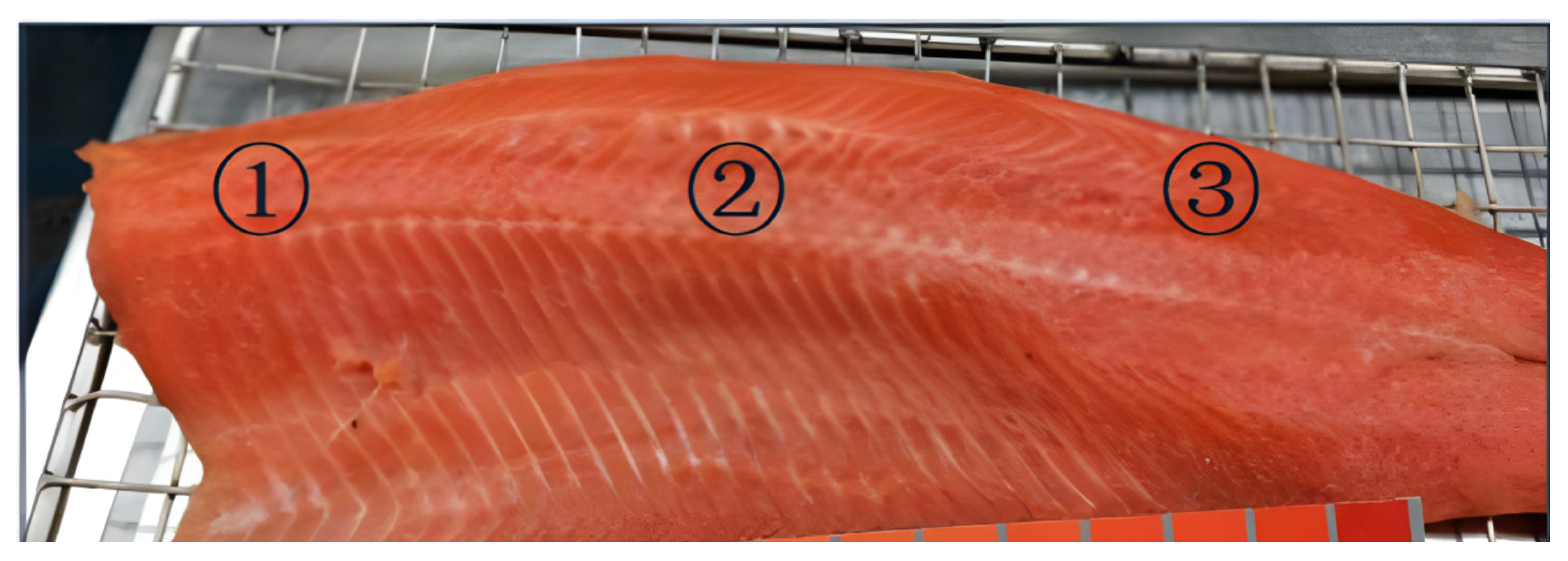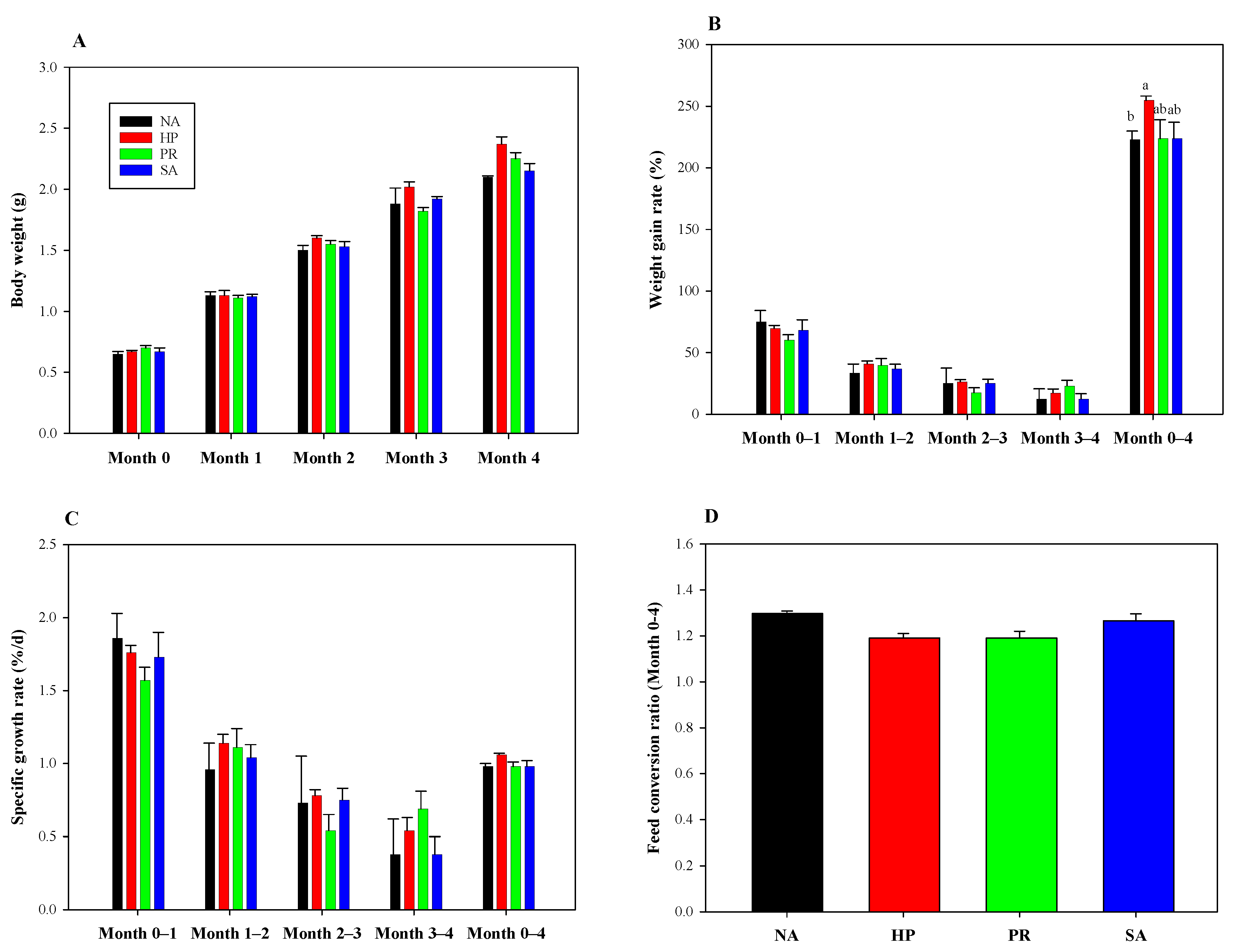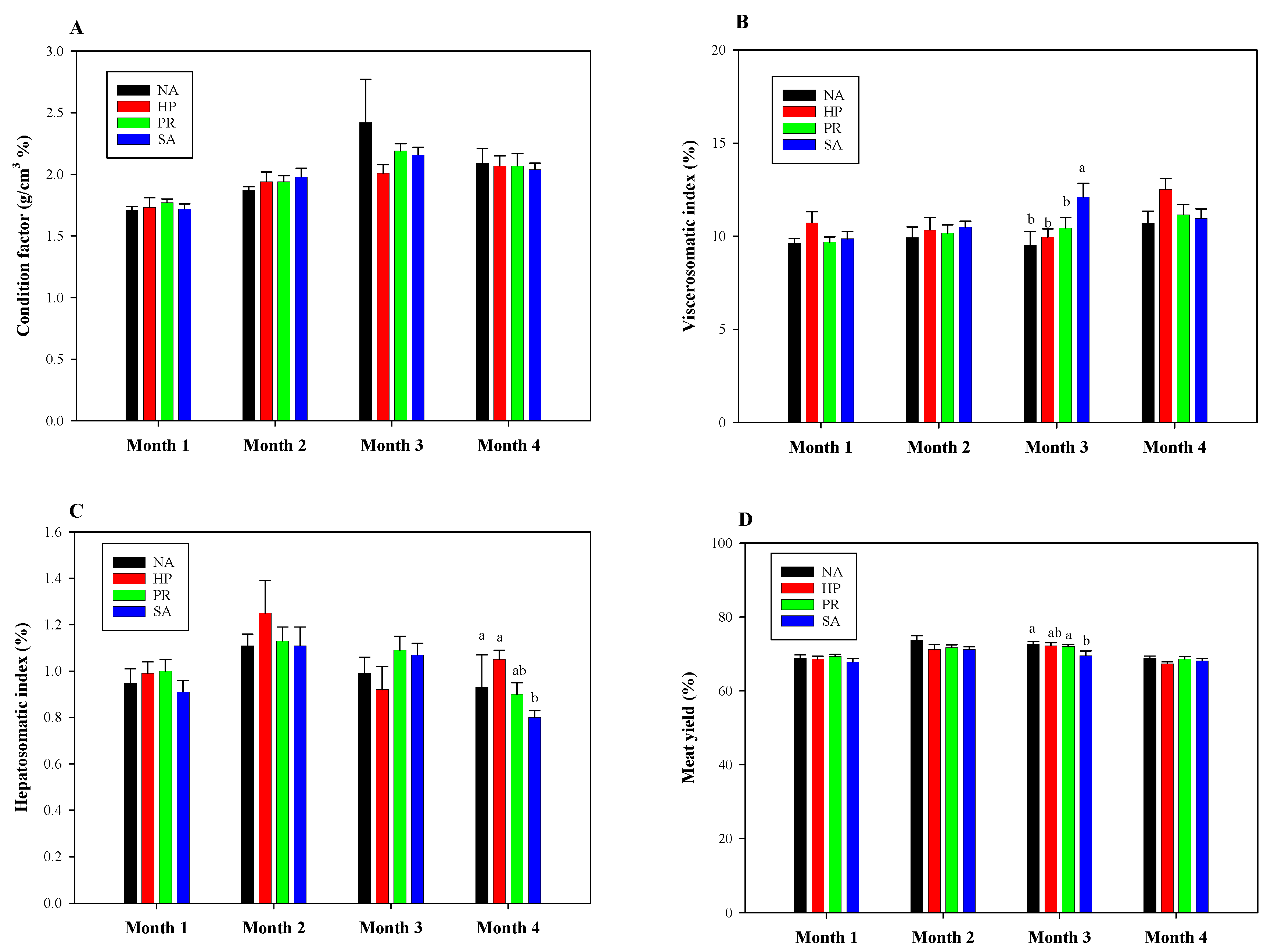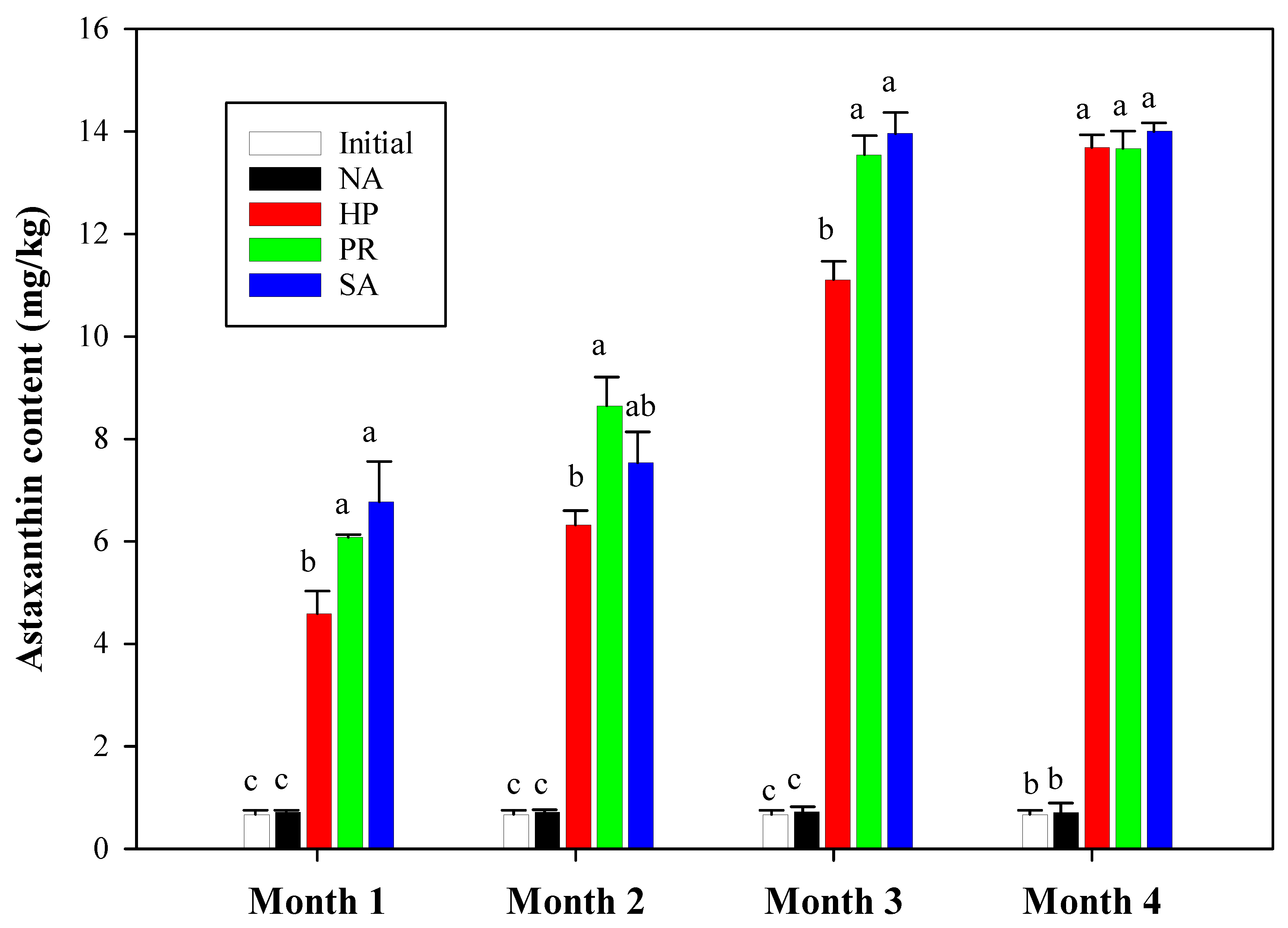Effects of Three Sources of Astaxanthin on the Growth, Coloration, and Antioxidant Capacity of Rainbow Trout (Oncorhynchus mykiss) during Long-Term Feeding
Abstract
:1. Introduction
2. Materials and Methods
2.1. Ethics Statement
2.2. Experimental Diets
2.3. Experimental Setup and Culture Management
2.4. Sample Collection and Color Parameter Measurement
2.5. Proximate Composition and Astaxanthin Content Analysis
2.6. Antioxidant Capacity Indexes Determination
2.7. Data Analysis
3. Results
3.1. Growth Performance and Tissue Indexes
3.2. Color Value and Astaxanthin Content of Fillet
3.3. Antioxidant Capacity Indices of Liver and Serum
3.4. Biochemical Composition of Fillet
4. Discussion
5. Conclusions
Author Contributions
Funding
Institutional Review Board Statement
Data Availability Statement
Acknowledgments
Conflicts of Interest
References
- Rebolé, A.; Velasco, S.; Rodríguez, M.L.; Treviño, J.; Alzueta, C.; Tejedor, J.L.; Ortiz, L.T. Nutrient content in the muscle and skin of fillets from farmed rainbow trout (Oncorhynchus mykiss). Food Chem. 2015, 174, 614–620. [Google Scholar] [CrossRef] [PubMed]
- Rahman, M.M.; Khosravi, S.; Chang, K.H.; Lee, S.M. Effects of dietary inclusion of astaxanthin on growth, muscle pigmentation and antioxidant capacity of juvenile rainbow trout (Oncorhynchus mykiss). Prev. Nutr. Food Sci. 2016, 21, 281–288. [Google Scholar] [CrossRef] [PubMed]
- Yanar, M.; Büyükçapar, H.M.; Yanar, Y. Effects of hot and sweet red peppers (Capsicum annum) as feed supplements on pigmentation, sensory properties and weight gain of rainbow trout (Oncorhynchus mykiss). Ann. Anim. Sci. 2016, 16, 825–834. [Google Scholar] [CrossRef]
- Roncarati, A.; Sirri, F.; Felici, A.; Stocchi, L.; Melotti, P.; Meluzzi, A. Effects of dietary supplementation with krill meal on pigmentation and quality of flesh of rainbow trout (Oncorhynchus mykiss). Ital. J. Anim. Sci. 2011, 10, e27. [Google Scholar] [CrossRef]
- Keleştemur, G.T.; Çoban, O.E. Effects of the β-carotene on the growth performance and skin pigmentation of rainbow trout (Oncorhynchus mykiss, W. 1792). J. Fish. Livest. Prod. 2016, 4, 164–169. [Google Scholar]
- Choubert, G.; Mendes-Pinto, M.M.; Morais, R. Pigmenting efficacy of astaxanthin fed to rainbow trout (Oncorhynchus mykiss): Effect of dietary astaxanthin and lipid sources. Aquaculture 2006, 257, 429–436. [Google Scholar] [CrossRef]
- Tejera, N.; Cejas, J.R.; Rodríguez, C.; Bjerkeng, B.; Jerez, S.; Bolaños, A.; Lorenzo, A. Pigmentation, carotenoids, lipid peroxides and lipid composition of skin of red porgy (Pagrus pagrus) fed diets supplemented with different astaxanthin sources. Aquaculture 2007, 270, 218–230. [Google Scholar] [CrossRef]
- Bjerkeng, B.; Peisker, M.; Von Schwartzenberg, K.; Ytrestøyl, T.; Åsgård, T. Digestibility and muscle retention of astaxanthin in Atlantic salmon, Salmo salar, fed diets with the red yeast Phaffia rhodozyma in comparison with synthetic formulated astaxanthin. Aquaculture 2007, 269, 476–489. [Google Scholar] [CrossRef]
- Capelli, B.; Bagchi, D.; Cysewski, G.R. Synthetic astaxanthin is significantly inferior to algal-based astaxanthin as an antioxidant and may not be suitable as a human nutraceutical supplement. Nutrafoods 2013, 12, 145–152. [Google Scholar] [CrossRef]
- Long, X.W.; Wu, X.G.; Zhao, L.; Liu, J.G.; Cheng, Y.X. Effects of dietary supplementation with Haematococcus pluvialis cell powder on coloration, ovarian development and antioxidation capacity of adult female Chinese mitten crab, Eriocheir sinensis. Aquaculture 2017, 473, 545–553. [Google Scholar] [CrossRef]
- Ishibashi, T. Manufacture production of carotenoid from Paracoccus bacterium. Seibutsu-Kogaku Kaishi 2015, 93, 388–390. [Google Scholar]
- Jackson, H.; Braun, C.L.; Ernst, H. The chemistry of novel xanthophyll carotenoids. Am. J. Cardiol. 2008, 101, S50–S57. [Google Scholar] [CrossRef] [PubMed]
- Fernandes, A.S.; do Nascimento, T.C.; Jacob-Lopes, E.; De Rosso, V.V.; Zepka, L.Q. Carotenoids: A brief overview on its structure, biosynthesis, synthesis, and applications. In Progress in Carotenoid Research; IntechOpen: London, UK, 2018; Volume 1, pp. 1–17. [Google Scholar]
- Bjornland, T. Distribution patterns of carotenoids in relation to chromophyte phylogeny and systematics. The chromophyte algae: Problems and perspectives. Syst. Assoc. Spec. 1989, 38, 37–60. [Google Scholar]
- European Food Safety Authority (EFSA). Scientific opinion of the panel on biological hazards (BIOHAZ)-monitoring of verotoxigenic Escherichia coli (VTEC) and identification of human pathogenic VTEC types. EFSA J. 2007, 5, 579. [Google Scholar] [CrossRef]
- Régnier, P.; Bastias, J.; Rodriguez-Ruiz, V.; Caballero-Casero, N.; Caballo, C.; Sicilia, D.; Fuentes, A.; Maire, M.; Crepin, M.; Letourneur, D.; et al. Astaxanthin from Haematococcus pluvialis prevents oxidative stress on human endothelial cells without toxicity. Mar. Drugs 2015, 13, 2857–2874. [Google Scholar] [CrossRef] [PubMed]
- Osawa, Y.; Nishi, R.; Kuwahara, D.; Haga, Y.; Honda, M. Improved flesh pigmentation of rainbow trout (Oncorhynchus mykiss) by feeding Z-isomer-rich astaxanthin derived from natural origin. J. Oleo Sci. 2024, 73, 35–43. [Google Scholar] [CrossRef] [PubMed]
- Sheikhzadeh, N.; Tayefi-Nasrabadi, H.; Khani Oushani, A.; Najafi Enferadi, M.H. Effects of Haematococcus pluvialis supplementation on antioxidant system and metabolism in rainbow trout (Oncorhynchus mykiss). Fish Physiol. Biochem. 2012, 38, 413–419. [Google Scholar] [CrossRef]
- Niu, J.; Wen, H.; Li, C.H.; Liu, Y.J.; Tian, L.X.; Chen, X.; Lin, H.Z. Comparison effect of dietary astaxanthin and β-carotene in the presence and absence of cholesterol supplementation on growth performance, antioxidant capacity and gene expression of Penaeus monodon under normoxia and hypoxia condition. Aquaculture 2014, 422, 8–17. [Google Scholar] [CrossRef]
- Elia, A.C.; Prearo, M.; Dörr, A.J.M.; Pacini, N.; Magara, G.; Brizio, P.; Abete, M.C. Effects of astaxanthin and canthaxanthin on oxidative stress biomarkers in rainbow trout. J. Toxicol. Environ. Health 2019, 82A, 760–768. [Google Scholar] [CrossRef]
- Kobayashi, M.; Sakamoto, Y.J.B.L. Singlet oxygen quenching ability of astaxanthin esters from the green alga Haematococcus pluvialis. Biotechnol. Lett. 1999, 21, 265–269. [Google Scholar] [CrossRef]
- Ju, Z.Y.; Deng, D.F.; Dominy, W.G.; Forster, I.P. Pigmentation of Pacific white shrimp, Litopenaeus vannamei, by dietary astaxanthin extracted from Haematococcus pluvialis. J. World Aquacult. Soc. 2011, 42, 633–644. [Google Scholar] [CrossRef]
- Rao, A.R.; Sindhuja, H.N.; Dharmesh, S.M.; Sankar, K.U.; Sarada, R.; Ravishankar, G.A. Effective inhibition of skin cancer, tyrosinase, and antioxidative properties by astaxanthin and astaxanthin esters from the green alga Haematococcus pluvialis. J. Agric. Food Chem. 2013, 61, 3842–3851. [Google Scholar] [CrossRef] [PubMed]
- Liu, X.; Luo, Q.; Cao, Y.; Goulette, T.; Liu, X.; Xiao, H. Mechanism of different stereoisomeric astaxanthin in resistance to oxidative stress in Caenorhabditis elegans. J. Food Sci. 2016, 81, H2280–H2287. [Google Scholar] [CrossRef] [PubMed]
- Liu, X.; Luo, Q.; Rakariyatham, K.; Cao, Y.; Goulette, T.; Liu, X.; Xiao, H. Antioxidation and anti-ageing activities of different stereoisomeric astaxanthin in vitro and in vivo. J. Funct. Foods 2016, 25, 50–61. [Google Scholar] [CrossRef]
- Choubert, G.; Heinrich, O. Carotenoid pigments of the green alga Haematococcus pluvialis: Assay on rainbow trout, Oncorhynchus mykiss, pigmentation in comparison with synthetic astaxanthin and canthaxanthin. Aquaculture 1993, 112, 217–226. [Google Scholar] [CrossRef]
- Christiansen, R.; Glette, J.; Lie, Ø.; Torrissen, O.J.; Waagbø, R. Antioxidant status and immunity in Atlantic salmon (Salmo salar) fed semi-purified diets with and without astaxanthin supplementation. J. Fish Dis. 2010, 18, 317–328. [Google Scholar] [CrossRef]
- Zhao, X.; Hu, J.; Zhang, X.; Li, X.; Leng, X.; Wu, S.; Cheng, D. Effects of E/Z isomers and coating materials of astaxanthin products on the pigmentation and antioxidation of rainbow trout (Oncorhynchus mykiss). J. World Aquacult. Soc. 2016, 47, 341–351. [Google Scholar] [CrossRef]
- Choi, J.; Rahman, M.M.; Lee, S.Y.; Chang, K.H.; Lee, S.M. Effects of dietary inclusion of fermented soybean meal with Phaffia rhodozyma on growth, muscle pigmentation, and antioxidant activity of juvenile rainbow trout (Oncorhynchus mykiss). Turk. J. Fish. Aquat. Sc. 2016, 16, 91–101. [Google Scholar]
- Gormley, T.R. A note on consumer preference of smoked Salmon colour. Ir. J. Agric. Food Res. 1992, 31, 199–202. [Google Scholar]
- Zhou, J.Y.; Ye, H. Determination of moisture in muscle by freeze-drying method and oven method and its effect on the determination of crude protein and crude fat. China Poult. 2017, 39, 51–53. [Google Scholar]
- AOAC (Association of Official Analytical Chemists). Official Methods of Analysis of Official Analytical Chemists International, 16th ed.; Association of Official Analytical Chemists: Arlington, VA, USA, 1995. [Google Scholar]
- Folch, J.; Lees, M.; Sloane Stanley, G.H. A simple method for the isolation and purification of total lipides from animal tissues. J. Biol. Chem. 1957, 226, 497–509. [Google Scholar] [CrossRef] [PubMed]
- Gao, Y.; Xing, L.; Sun, W.; Wu, X.; Zu, L.; Ning, J.; Zhai, Y.; Tan, Z. Comparison of astaxanthin and fatty acid in different parts of farmed Salmo salar and Oncorhynchus mykiss. Food Ferment. Ind. 2021, 47, 235–243. [Google Scholar]
- SC/T 3053; Determination of Astaxanthin in Aquatic Products and Their Products High Performance Liquid Chromatography. Ministry of Agriculture and Rural Affairs of the People’s Republic of China: Beijing, China, 2019.
- Christiansen, R.; Lie, O.; Torrissen, O.J. Growth and survival of Atlantic salmon, Salmo salar L.; fed different dietary levels of astaxanthin. First-feeding fry. Aquacult. Nutr. 1995, 1, 189–198. [Google Scholar] [CrossRef]
- Tao, Z.; Kuang, J.; Chen, X. Effects of astaxanthin on coloring and production performance of rainbow trout (Oncorhynchus mykiss). Feed Anim. Husb. 2010, 34–37. [Google Scholar]
- El Basuini, M.F.; El-Bilawy, E.H.; Kari, Z.A.; Raza, S.H.A.; Tapingkae, W.; Van Doan, H.; Dawood, M.A. Pharmacotherapeutic potential of astaxanthin: Human and animal targeting roles—A review. Ann. Anim. Sci. 2022, 22, 829–838. [Google Scholar] [CrossRef]
- Zhang, C.; Wen, D.; Yao, W.; Li, X.; Wu, S.; Leng, X. Effects of different astaxanthin sources on growth performance, flesh color and antioxidant ability of rainbow trout (Oncorhynchus Mykiss). Chin. J. Anim. Nutr. 2021, 33, 1008–1019. [Google Scholar]
- Yanar, Y.; Büyükçapar, H.; Yanar, M.; Göcer, M. Effect of carotenoids from red pepper and marigold flower on pigmentation, sensory properties and fatty acid composition of rainbow trout. Food Chem. 2007, 100, 326–330. [Google Scholar] [CrossRef]
- Amar, E.C.; Kiron, V.; Satoh, S.; Watanabe, T. Influence of various dietary synthetic carotenoids on bio-defence mechanisms in rainbow trout, Oncorhynchus mykiss (Walbaum). Aquac. Res. 2001, 32, 162–173. [Google Scholar] [CrossRef]
- Sigurgisladottir, S.; ØTorrissen, O.; Lie, Ø.; Thomassen, M.; Hafsteinsson, H. Salmon quality: Methods to determine the quality parameters. Rev. Fish. Sci. 1997, 5, 223–252. [Google Scholar] [CrossRef]
- Ostrander, J.; Martinsen, C.; Liston, J.; McCullough, J. Sensory testing of pen-reared salmon and trout. J. Food Sci. 1976, 41, 386–390. [Google Scholar] [CrossRef]
- Anderson, S. Salmon Color and the Consumer. In Microbehavior and Macroresults, Proceedings of the Tenth Biennial Conference of the International Institute of Fisheries Economics and Trade, Corvallis, OR, USA, 10–14 July 2000; Johnston, R.S., Shriver, A.L., Eds.; International Institute of Fisheries Economics and Trade (IIFET): Corvallis, OR, USA, 2001. [Google Scholar]
- Alfnes, F.; Guttormsen, A.G.; Steine, G.; Kolstad, K. Consumers’ willingness to pay for the color of salmon: A choice experiment with real economic incentives. Am. J. Agric. Econ. 2006, 88, 1050–1061. [Google Scholar] [CrossRef]
- Brown, J.A.; Shahidi, F. Effects of stocking density on colour characteristics and deposition of carotenoids in cultured Arctic charr (Salvelinus alpinus). Food Chem. 1997, 59, 107–114. [Google Scholar]
- Dissing, B.S.; Nielsen, M.E.; Ersbøll, B.K.; Frosch, S. Multispectral imaging for determination of astaxanthin concentration in salmonids. PLoS ONE 2011, 6, e19032. [Google Scholar] [CrossRef] [PubMed]
- Sun, W.; Lin, H.; Zhai, Y.; Leng, K.; Xing, L. Separation, Purification and Identification of (3R,3’R)-trans-Astaxanthin from Phaffia rhodozyma. Food Sci. 2014, 35, 79–82. [Google Scholar]
- Foss, P.; Renstrøm, B.; Liaaen-Jensen, S. Natural occurrence of enantiomeric and Meso astaxanthin 7∗-crustaceans including zooplankton. Comp. Biochem. Phys. 1987, 86B, 313–314. [Google Scholar] [CrossRef]
- Chien, Y.H.; Shiau, W.C. The effects of dietary supplementation of algae and synthetic astaxanthin on body astaxanthin, survival, growth, and low dissolved oxygen stress resistance of kuruma prawn, Marsupenaeus japonicus Bate. J. Exp. Mar. Biol. Ecol. 2005, 318, 201–211. [Google Scholar] [CrossRef]
- Maoka, T. Carotenoids in marine animals. Mar. Drugs 2011, 9, 278–293. [Google Scholar] [CrossRef] [PubMed]
- Wu, K.; Cleveland, B.M.; Portman, M.; Sealey, W.M.; Lei, X.G. Supplemental microalgal DHA and astaxanthin affect astaxanthin metabolism and redox status of juvenile rainbow trout. Antioxidants 2021, 10, 16. [Google Scholar] [CrossRef] [PubMed]
- Johnson, E.A.; An, G.H. Astaxanthin from microbial sources. Crit. Rev. Biotechnol. 1991, 11, 297–326. [Google Scholar] [CrossRef]
- Sommer, T.R.; D’souza, F.M.L.; Morrissy, N.M. Pigmentation of adult rainbow trout (Oncorhynchus mykiss) using the green alga Haematococcus pluvialis. Aquaculture 1992, 106, 63–74. [Google Scholar] [CrossRef]
- Lygren, B.; Hamre, K.; Waagbø, R. Effects of dietary pro-and antioxidants on some protective mechanisms and health parameters in Atlantic salmon. J. Aquat. Anim. Health 1999, 11, 211–221. [Google Scholar] [CrossRef]
- Zhang, J.; Li, X.; Leng, X.; Zhang, C.; Han, Z.; Zhang, F. Effects of dietary astaxanthins on pigmentation of flesh and tissue antioxidation of rainbow trout (Oncorhynchus mykiss). Aquacult. Int. 2013, 21, 579–589. [Google Scholar] [CrossRef]
- Zhu, X.; Cao, J.M.; Zhao, H.X.; Zhang, H.T. Effects of dietary glutathione on tissue glutathione retention and anti-oxidative activities in juvenile grass carp Ctenopharyngodon idella. J. Fish. Sci. China 2008, 15, 160–166. [Google Scholar]
- Li, C.; Cui, J.; Zhou, X.; Huang, D.Q. Flavonoids from Gnaphalium affine D. Don. Ameliorate antioxidant capacity in diabetic mice. Food Sci. 2013, 34, 311–314. [Google Scholar]
- Dose, J.; Matsugo, S.; Yokokawa, H.; Koshida, Y.; Okazaki, S.; Seidel, U.; Eggersdorfer, M.; Rimbach, G.; Esatbeyoglu, T. Free radical scavenging and cellular antioxidant properties of astaxanthin. Int. J. Mol. Sci. 2016, 17, 103. [Google Scholar] [CrossRef] [PubMed]
- Niu, T.T.; Xuan, R.R.; Jiang, L.G.; Wu, W.; Zhen, Z.H.; Song, Y.L.; Hong, L.L.; Zheng, K.Q.; Zhang, J.X.; Xu, Q.S.; et al. Astaxanthin induces the Nrf2/HO-1 antioxidant pathway in human umbilical vein endothelial cells by generating trace amounts of ROS. J. Agric. Food Chem. 2018, 66, 1551–1559. [Google Scholar] [CrossRef] [PubMed]
- Ding, R.; Feng, M.L.; Chen, A.Q. Evaluation of antioxidant capacity of astaxanthin from different sources based on HepG2 cells. Food Ferment. Ind. 2023, 49, 172–176, 182. [Google Scholar]
- Řehulka, J. Influence of astaxanthin on growth rate, condition, and some blood indices of rainbow trout (Oncorhynchus mykiss). Aquaculture 2000, 190, 27–47. [Google Scholar] [CrossRef]
- Kalinowski, C.T.; Robaina, L.E.; Izquierdo, M.S. Effect of dietary astaxanthin on the growth performance, lipid composition and post-mortem skin colouration of red porgy (Pagrus pagrus). Aquacult. Int. 2011, 19, 811–823. [Google Scholar] [CrossRef]
- Wang, J.; Xiong, J.; Zhang, D. Effects of dietary astaxanthin on growth, body color, antioxidant capacity and immunity of Koi. Chin. J. Anim. Nutr. 2019, 31, 4144–4151. [Google Scholar]
- Amar, E.C.; Kiron, V.; Satoh, S.; Watanabe, T. Enhancement of innate immunity in rainbow trout Oncorhynchus mykiss (Walbaum) associated with dietary intake of carotenoids from natural products. Fish Shellfish Immun. 2004, 16, 527–537. [Google Scholar] [CrossRef]
- Amar, E.C.; Kiron, V.; Akutsu, T.; Satoh, S.; Watanabe, T. Resistance of rainbow trout Oncorhynchus mykiss to infectious hematopoietic necrosis virus (IHNV) experimental infection following ingestion of natural and synthetic carotenoids. Aquaculture 2012, 330, 148–155. [Google Scholar] [CrossRef]
- Wu, R.F.; Long, X.W.; Hou, W.J.; Pan, G.P.; Liu, J.G.; Cheng, Y.X.; Wu, X.G. Effects of dietary supplementation with Haematococcus pluvialis power on ovarian development, coloration, antioxidant capacity and biochemical composition of adult swimming crab, Portunus trituberculatus. Acta Hydrobiol. Sin. 2018, 42, 698–708. [Google Scholar]
- Ong, D.E.; Chytil, F. Retinoic acid-binding protein in rat tissue. Partial purification and comparison to rat tissue retinol-binding protein. J. Biol. Chem. 1975, 250, 6113–6117. [Google Scholar] [CrossRef] [PubMed]
- Britton, G. Functions of intact carotenoids. In Carotenoids. Volume 4: Natural Functions; Britton, G., Liaaen-Jensen, S., Pfander, H., Eds.; Birkhauser Verlag AG: Basel, Switzerland, 2008; pp. 189–212. [Google Scholar]







| Items | NA | HP | PR | SA |
|---|---|---|---|---|
| Moisture (% dry diet) | 9.37 | 10.13 | 9.35 | 9.58 |
| Crude protein (% dry diet) | 42.37 | 42.02 | 42.85 | 42.81 |
| Total lipids (% dry diet) | 24.04 | 24.71 | 24.53 | 24.54 |
| Ash (% dry diet) | 6.91 | 6.88 | 7.03 | 6.80 |
| Astaxanthin (mg/kg dry diet) | 0 | 31.25 | 32.96 | 31.50 |
| Items | NA | HP | PR | SA |
|---|---|---|---|---|
| Liver | ||||
| T-AOC (U/mg protein) | 0.64 ± 0.07 c | 1.58 ± 0.07 a | 0.76 ± 0.12 bc | 1.02 ± 0.14 b |
| T-SOD (U/mg protein) | 20.66 ± 1.12 ab | 22.41 ± 0.89 a | 18.54 ± 0.65 b | 20.32 ± 1.11 ab |
| GSH-Px (U/mg protein) | 20.99 ± 1.11 b | 27.54 ± 1.73 a | 29.97 ± 1.60 a | 30.16 ± 1.77 a |
| MDA (nmol/mg protein) | 1.30 ± 0.07 a | 0.64 ± 0.05 b | 0.83 ± 0.06 b | 0.83 ± 0.05 b |
| Serum | ||||
| T-AOC (U/mL) | 8.52 ± 0.41 c | 16.43 ± 0.32 a | 11.74 ± 0.51 b | 11.06 ± 0.54 b |
| T-SOD (U/mL) | 103.03 ± 1.99 a | 84.51 ± 2.03 b | 103.18 ± 2.09 a | 103.97 ± 2.37 a |
| GSH-Px (U/mL) | 97.30 ± 4.45 b | 132.47 ± 5.29 a | 96.52 ± 2.54 b | 98.00 ± 5.07 b |
| MDA (nmol/mL) | 33.75 ± 1.50 a | 16.63 ± 0.76 b | 18.70 ± 0.25 b | 19.15 ± 0.20 b |
| Items | NA | HP | PR | SA |
|---|---|---|---|---|
| Moisture (% wet fillet) | 65.36 ± 0.47 bc | 67.76 ± 1.10 b | 69.06 ± 0.84 a | 63.82 ± 0.30 c |
| Crude protein (% wet fillet) | 22.48 ± 1.00 | 21.58 ± 0.92 | 21.78 ± 0.29 | 22.14 ± 0.39 |
| Total lipids (% wet fillet) | 7.52 ± 0.95 b | 10.63 ± 0.12 a | 7.57 ± 0.73 b | 9.00 ± 0.59 ab |
| Ash (% wet fillet) | 1.88 ± 0.09 b | 2.03 ± 0.06 b | 2.45 ± 0.07 a | 2.09 ± 0.16 b |
Disclaimer/Publisher’s Note: The statements, opinions and data contained in all publications are solely those of the individual author(s) and contributor(s) and not of MDPI and/or the editor(s). MDPI and/or the editor(s) disclaim responsibility for any injury to people or property resulting from any ideas, methods, instructions or products referred to in the content. |
© 2024 by the authors. Licensee MDPI, Basel, Switzerland. This article is an open access article distributed under the terms and conditions of the Creative Commons Attribution (CC BY) license (https://creativecommons.org/licenses/by/4.0/).
Share and Cite
Wang, L.; Long, X.; Li, Y.; Zhang, Y.; Sun, W.; Wu, X. Effects of Three Sources of Astaxanthin on the Growth, Coloration, and Antioxidant Capacity of Rainbow Trout (Oncorhynchus mykiss) during Long-Term Feeding. Fishes 2024, 9, 174. https://doi.org/10.3390/fishes9050174
Wang L, Long X, Li Y, Zhang Y, Sun W, Wu X. Effects of Three Sources of Astaxanthin on the Growth, Coloration, and Antioxidant Capacity of Rainbow Trout (Oncorhynchus mykiss) during Long-Term Feeding. Fishes. 2024; 9(5):174. https://doi.org/10.3390/fishes9050174
Chicago/Turabian StyleWang, Lei, Xiaowen Long, Yaopeng Li, Yong Zhang, Weihong Sun, and Xugan Wu. 2024. "Effects of Three Sources of Astaxanthin on the Growth, Coloration, and Antioxidant Capacity of Rainbow Trout (Oncorhynchus mykiss) during Long-Term Feeding" Fishes 9, no. 5: 174. https://doi.org/10.3390/fishes9050174




